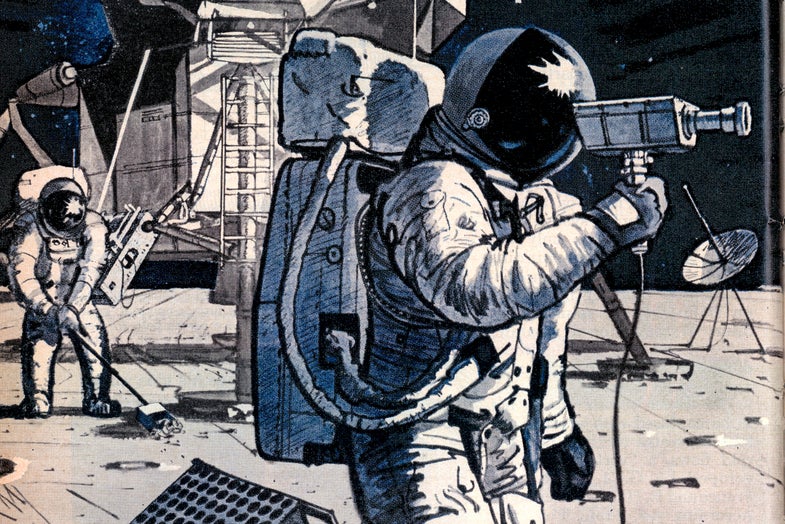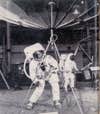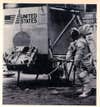Here’s our original coverage of Apollo 11
In the July 1969 issue of Popular Science, a famous rocket scientist narrated the first moon landing.

Forty-eight years ago, on July 20, 1969, Neil Armstrong and Buzz Aldrin made the first footprints on the Moon, and it was epic. Popular Science covered this enormous achievement with an article by Wernher von Braun—a German-born engineer, now known as “The Father of Rocket Science,” who built the Saturn V launch vehicle that brought Apollo to the Moon. In our July 1969 issue, he described the plans for Armstrong and Aldrin’s two-hour rendevous with the Moon. (You can read the story in its original format here, although for mysterious reasons, two pages are missing.)

From The Archives.
First Men On The Moon
By Dr. Wernher von Braun
In the two-man cabin of the Apollo 11 Lunar Module, slowly riding down its vertical rocket jet, blue signal lights flash on. Probes dangling 60 inches below the disk-shaped footpads have touched the moon. The pilot cuts the engine. A moment later, a mild jar tells the crew they have landed on the moon’s surface.
That is to happen early in the afternoon of Sunday, July 20, 1969, in the western part of the moon’s Sea of Tranquility, according to NASA’s plans at this writing. Chosen to attempt the first manned lunar touchdown are Apollo 11 Commander Neil Armstrong and Lunar Module Pilot Edwin (“Buzz”) Aldrin. Circling above the landing site in their moon-orbiting mother spaceship, in the Command and Service Module, will be Command Module Pilot Michael Collins.
Success in Apollo 11’s great adventure would realize our aim of putting men on the moon within this decade. Millions of Americans will share the suspense and thrills of the fantastic mission as they watch it unfold on their TV screens. Here is an advance look at what the Apollo 11 astronauts mean to do, and a guide to key events on which success will hang:

The dash to the summit.
Man’s first touchdown on the moon can be compared to the final spurt to a lofty mountain’s summit by a few select climbers, starting from the highest of a string of base camps set up by others of their expedition.
Apollo 7 proved out the Comand and Service Module (CSM). Apollo 8’s moon voyage took men in and out of lunar orbit. Separating and docking the Lunar Module (LM) was rehearsed in earth orbit by Apollo9, and over the moon by Apollo 10. Now all is ready for the assault on the summit–the moon landing itself.
Apollo 11, up to a point, will retrace the moon-voyaging route of Apollo 8 and 10: the Saturn V launch into earth orbit, scheduled for July 16; re-ignition of the Saturn V’s top stage, to propel the craft into a coast to the moon; and rocket braking to put Apollo 11 in a lunar orbit, 70 statute miles above the surface. (The “go” for each major maneuver will mean that crew and spacecraft are in perfect shape so far; should trouble strike, anywhere along ‘the way, the mission would be aborted and the crew brought back.
Then the Lunar Module with its crew of two is to separate and make a rocket braking burn that, in an hour, brings it down to 50,000 feet above the moon. This maneuver has been performed before only by the Apollo 10 astronauts.
From here on, Apollo 11’s Lunar Module will blaze a new trail.
Coming in to Iand.
The all-clear for what has never been done before will be the radioed word from Mission Control at Houston: “You are go for PDI.” That stands for Powered Descent Initiation, the start of rocket braking so forceful that it commits the Lunar Module to a lunar landing attempt within minutes.
Feet first, the Lunar Module is skimming the moon at about 4,500 m.p.h., when its crew fires its descent engine straight forward. The retro-burn lasts six minutes at full 10,000-pound thrust–and two minutes more, with the LM now lightened by propellant consumption, at 6,000-pound thrust. That “braking phase” kills almost all forward velocity. It leaves the Lunar Module nearing the landing site at airplane-like speed of only a few hundred miles an hour.
As the craft turns upright, the moon’s surface, out of sight of the crew before, creeps into view from the bottom of their windows.
A landing radar has begun reporting altitude and velocity-data so vital that the landing attempt would have to be abandoned if the radar beams failed to “lock on” to the moon’s surface. At a point called the High Gate, less than five miles from touchdown, the falling craft is down to 7,000-foot altitude–and enters the Final Approach Phase. It begins tilting toward vertical and using its descent engine to check its fall.
As it turns upright, the moon’s surface, out of sight of the crew before, creeps into view from the bottoms of their windows. What they see is a flat and comparatively crater-free lunar plain–almost on the moon’s equator, at 23 degrees east, lunar longitude.
Look at the moon from earth and this landing site will be a little short of midway from the moon’s center to its righthand edge. At the time of the landing, when the moon will be nearing “first quarter,” it is barely within the sunlit zone. Purposely the touchdown is timed for early in the lunar morning, so that long shadows will vividly show up the relief of the terrain.
Selecting a landing spot free of obstacles, the crew tilts the whole craft until this target is at the zero point of a windowpane scale, whose fluorescent markings glow green and orange in the dark. Then they trigger a “mark” button to pin it down. This sets their inertial-guidance system to lead their descent path to it automatically.
At a point less than 1,000 feet up, called the Low Gate, the Final Approach Phase ends and the Landing Phase begins. The crew can choose an “auto” mode that does it all automatically; a semiautomatic mode, in which the LM Pilot controls the rate of descent; or a completely manual mode for a helicopter-style landing by eye. A likely choice is the semiautomatic mode.
The hovering Lunar Module descends toward a touchdown at three feet a second. Any remaining horizontal velocity will be even less. Keeping it to a minimum, and avoiding sloping ground and obstacles, are important to avert a disastrous tip-over. The LM is pretty forgiving about a less-than-perfect landing–but, even so, it will be a tense moment when the spidery legs’ footpads settle into lunar soil.
After the dramatic news that the crew are safely down on the moon, a little time elapses before further events, for the astronauts do not emerge at once. It takes them awhile to check their craft, and then struggle into “moon suits” with life-support backpacks, even if they should forego a rest period before their strenuous activities outside.

Footsteps on the moon!
Finally comes the high spot of the mission–an action-packed program of two hours and 40 minutes of “moonwalking.” Descending a ladder from the forward hatch, Commander Armstrong is to be first to set foot on the moon. Almost his first act is to scoop up a bagful of loose lunar soil, and hand it up to Aldrin to stow away. That “grabbag” sample guards against returning empty-handed, if anything should compel a premature takeoff. (You may be sure planners are thinking of nothing so fanciful as a hostile reception by little green men–but of such imaginable contingencies as a leak in the ascent propulsion system, or trouble with life-support equipment.) Then, after Armstrong has tested walking on the moon, and inspected the craft’s exterior to make sure it has suffered no damage in landing, Aldrin joins him outside.
Earth viewers will share by TV the eerie lunar scene confronting them–a stark gray desert, airless and lifeless, unrelieved by colors, harshly painted by the sun with glaring highlights and inky shadows. High in the black sky hangs the remote earth. The only nearer human being is Collins in the CSM, which they see sail overhead every two hours. Their mothership looks to them like a star, except that it is moving rapidly across the heavens, as it orbits the moon.
Dark gold-coated visors of the moon-explorers’ red helmets shield their eyes from the sun’s glare. They wear heavily insulated “lunar overshoes”; underfoot, the moon’s soil is still frigid after the extreme cold of the 14-day-long lunar night, although it will become hotter than boiling water during the equally long lunar day.
Their TV views and their voices, via their walkie-talkies, are beamed to earth by a radio antenna shaped like an upside-down umbrella, which they have erected on the lunar soil. Eager shutterbugs, they snap away with film cameras, too.
Using long-handled scoops, tongs, and shovels for rock collecting, since they cannot bend over in their suits, they finish filling two “rock boxes” with carefully selected lunar specimens, individually sealed in plastic bags.

Science package for the moon.
Setting up three scientific experiments, of which two are left on the moon, completes the lunar explorers’ busy program.
A “moonquake detector,” powered by solar panels, is expected to report any seismic activity to the earth by radio for a year. It is so sensitive that it may transmit the sound of the astronauts’ footsteps as they walk away.
An array of 100 disk-shaped quartz reflectors, inclined to face the earth, will bounce back laser beams shot at it from earth stations. Through its use, scientists hope to measure earth-moon distance with unprecedented accuracy–and also to gauge the precise distance between laser stations on earth, for such purposes as testing theories of continental drift.
A sheet of plain aluminum foil, which the LM crewmen spread on the ground when they leave the craft and pick up again when they return, is a take-home experiment. Later it will reveal the composition of “solar wind” when it is tested for entrapped helium, neon, and other rare gases.
Together the three experiments–called EASEP, for Early Apollo Scientific Experiments Payload–weigh 171 earth pounds, or less than 30 pounds on the moon. Deploying them should take as little as 10 minutes. To avoid overtaxing the first moon men, NASA decided that bringing a more elaborate science outfit (called ALSEP, for Apollo Lunar Surface Experiments Package) would await subsequent moon-landing expeditions.
In the limited time of their sortie on the lunar surface, the explorers range no farther than 50 to 100 feet from their spacecraft. Returning to it, they spend the remainder of their 22 hours on the moon in resting from their demanding tasks, and in an elaborate prelaunch checkout of the equipment to be used in rejoining the orbiting CSM.
Earth viewers will share by TV the eerie lunar scene confronting them–a stark gray desert, airless and lifeless, unrelieved by colors, harshly painted by the sun with glaring highlights and inky shadows. High in the black sky hangs the remote earth.
“Fire in the hole.”
The first manned takeoff from the moon will be due about noon on Monday, July 21. Safety of the astronauts and their precious specimens will depend oh the success of the “FITH” launch of their spacecraft’s ascent stage. FITH stands for Fire in the Hole, and means that there is no separation of the stage prior to ignition of its ascent engine, nor is there a jet deflector of any sort. Having served its purpose, the now-expendable descent stage serves as a launch platform for the ascent stage, and damage to it from the ascent engine’s fiery jet will not matter.
For the first eight seconds the ascent stage climbs vertically, under its engine’s 3,500-pound thrust. Then it rather abruptly pitches downward about 50 degrees. Safely above lunar mountains and with no atmosphere to limit speed, it builds up horizontal velocity as fast as possible.
Seven minutes and 16 seconds after takeoff, the Lunar Module is speeding nearly horizontally at almost 3,400 m.p.h., 60,000 feet above the lunar surface. It is safely inserted in an elliptical orbit with a high point of 52 statute miles. If anything should go wrong with it now, the Command and Service Module can come to the LM crew’s rescue.
An hour later, the LM ascent stage circularizes its orbit at the high point, by adding a little speed with its small reaction control thrusters. Then a smaller nudge with them adjusts the altitude to put the craft just 17 and 1/4 miles below the CSM, and corrects any minor difference in their orbital planes. Now, from behind and below, the ascent stage makes its rendezvous-and-docking with the CSM.
The rest–the start for earth, the long coast through space, the high-speed re-entry and splashdown in the Pacific–will be a repeat of Apollo 8 and 10, up to the recovery of the astronauts and the Command Module.
Into quarantine.
Then comes the mission’s strange conclusion–quarantining the moon heroes and their lunar samples for at least three weeks, in the Lunar Receiving Laboratory at Houston [PS, Oct. ’68]. It is a precaution against the chance they might have brought back living organisms–probably unknown on earth and possibly harmful to humans, animals, or plant crops here–although scientists consider it far more likely that the moon lacks any life whatever. Within on ly a few weeks we may have the first hard evidence, pro or con.
Apollo 11’s flight is only a beginning, a scouting expedition. Nine more Apollo landings at different sites on the moon are planned by NASA; the next one, Apollo 12, is scheduled for this November. But the first manned landing on the moon will be an epic achievement–the conquest of the greatest engineering challenge we have ever faced.
This article originally appeared in the July 1969 issue of Popular Science.